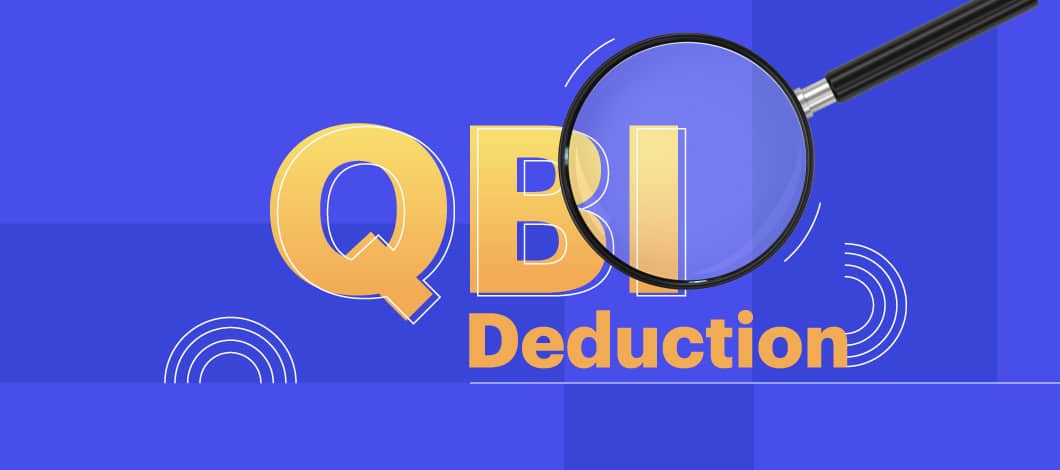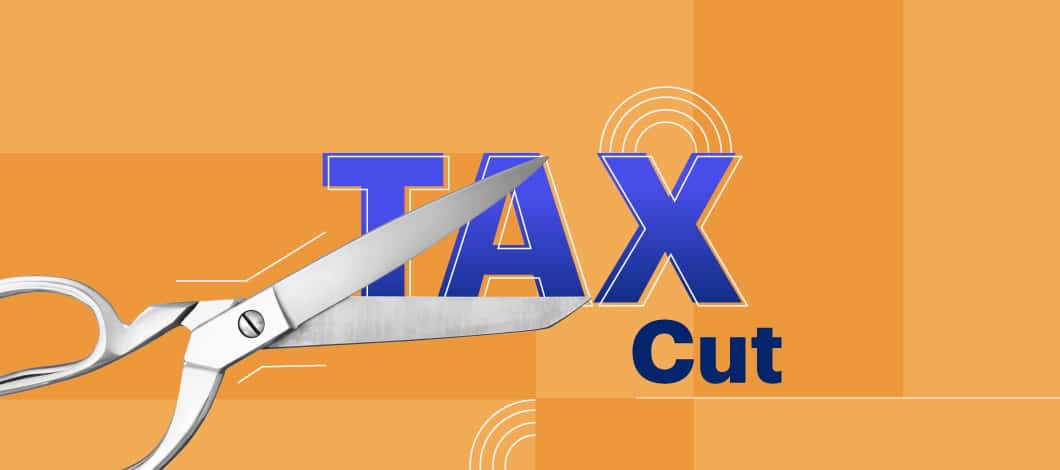The qualified business income (QBI) deduction allows most business owners to claim tax savings.
Find out whether you’re eligible. We’ll cover what it is, who qualifies, what the limitations are, how to claim your deduction and how to calculate it.
What Is the QBI Tax Deduction?
The QBI tax deduction, also known as the pass-through deduction or Internal Revenue Code Section 199A deduction, is an income tax deduction opportunity for owners of qualified trades and businesses, estates and trusts.
The QBI was introduced by the Tax Cuts and Jobs Act (TCJA) of 2017. It is available for tax years beginning after Dec. 31, 2017.
Deductions Up to 20% for Eligible Taxpayers
According to the IRS, the QBI deduction allows noncorporate business owners to claim a tax deduction of up to 20% on income classified as qualified business income.
This generally includes income earned from domestic businesses structured as noncorporate entities, namely sole proprietorships, partnerships and S corporations (businesses which “pass through” income to the owner or partner’s individual tax return) as well as trusts or estates. Income earned through a C corporation or income earned from providing services as an employee can’t be claimed.
Additionally, eligible taxpayers can also deduct 20% of qualified real estate investment trust (REIT) dividends and qualified publicly traded partnership (PTP) income, per IRS regulations.
Included and Excluded Income
Income that can be claimed as QBI generally includes the net amount of qualified items of income, gain, deduction and loss from any operation classified as a qualified trade or business. This includes the deductible component of self-employment tax, self-employed health insurance and deductions for contributions to eligible retirement plans. These items can only be counted if included in taxable income and connected with a U.S. trade or business, according to IRS rules.
QBI doesn’t include items such as capital gains and losses, certain dividends and interest income. QBI also excludes W-2 income, amounts received as reasonable compensation from an S corporation, amounts received as guaranteed payments from a partnership and payments received by a partner for services under Internal Revenue Code Section 707(a).

Who Qualifies for the QBI Deduction?
Under IRS regulations, eligibility for the QBI deduction extends to taxpayers and taxpaying entities in 2 main categories:
- Individuals who own qualified trades and businesses which aren’t classified as C corporations
- Some trusts and estates with QBI, qualified REIT dividends or qualified PTP income
Within these general guidelines, special rules apply for certain situations. We’ll cover some of the most important special rules. For more details, see the instructions for Form 8995 and Form 8895-A.
What Is a Qualified Trade or Business?
A qualified trade or business includes most businesses falling under Internal Revenue Code Section 162, with 3 exceptions:
- Trade or business conducted by C corporations
- Taxpayers with taxable income exceeding a specified threshold (for 2020, $326,600 for married filing jointly and $163,300 for other filers) who operate businesses on a QBI specified service trade or business list (QBI SSTB list) provided on IRS Form 8995 and 8995-A
- A trade or business where the filer is providing services as an employee
The QBI SSTB list includes any trade or business providing services in the fields of:
- Health
- Accounting
- Actuarial science
- Law
- Athletics
- Performing arts
- Consulting
- Investing and investment management
- Trading or dealing in securities, partnership interests or commodities
- Brokerage services
- Financial services
- Brokerage services
- Any trade or business where the principal asset is the reputation or talent of certain of its owners or employees, as evidenced by receiving fees for endorsements, media appearances or use of image or likeness
The SSTB exception doesn’t apply for taxpayers in SSTB industries with income up to the specified thresholds. For those with income exceeding these thresholds, if your income falls within a specified range (for 2020, between $326,600 and $426,600 for married filing jointly or between $163,300 and $213,300 for other filers), you can claim an applicable percentage of your SSTB as qualified trade or business by filing Schedule A (Form 8995-A).
If your income from an SSTB exceeds this range, you are no longer eligible for the deduction.
How Do S Corporations and Partnerships Handle QBI Deductions?
S corporations and partnerships normally aren’t taxable and can’t claim a QBI deduction themselves. However, under IRS rules, these entities report each shareholder’s or partner’s share of QBI items, W-2 wages, unadjusted basis in qualified property immediately after acquisition (UBIA) of qualified property, qualified REIT dividends and qualified PTP income items on a Schedule K-1, or on an attached statement, which shareholders or partners may use to determine their individual deduction.
How Do Cooperatives Handle QBI Deductions?
In certain instances, patrons of horticultural or agricultural cooperatives are required to decrease their deduction under Internal Revenue Code Section 199A(b)(7) (patron reduction). For rules applicable to cooperative associations, see IRS Form 1120-C.
How Do Electing Small Business Trusts (ESBTs) Handle QBI Deduction?
Trusts classified as ESBTs, which can hold stock in S corporations, must calculate QBI deductions separately for S and non-S portions of the trust. The Form 8995 used for calculating the S portion’s QBI deduction must be attached as a PDF to the ESBT tax worksheet filed with Form 1041.
The attachment must show that the information applies only to the S portion by writing “ESBT” in the top margin of the Form 8995. For additional information, see the instructions for Form 1041.
What If I Run Multiple Businesses?
If you run separate trades or businesses, each one is separate for purposes of QBI deduction. However, in certain circumstances laid out in the instructions for Form 8995, you can opt to aggregate your trades and businesses for purposes of calculating your QBI deduction. See the Form 8995 instructions for additional details.
What Are the QBI Limitations for Income?
QBI income limitation considerations kick in once your income exceeds thresholds defined for a given year by the IRS. For 2020, the thresholds are $326,600 for taxpayers married filing jointly and $163,300 for other filers. Once you hit these thresholds, your QBI becomes subject to limits under the following scenarios:
- If your business is classified as an SSTB and your income falls within a specified range called the phase-in range (for 2020, between $326,600 and $426,600 for married filing jointly or between $163,300 and $213,300 for others), you can still claim an applicable percentage of your SSTB as qualified trade or business by filing Schedule A (Form 8995-A), otherwise you can’t claim a QBI deduction if your income exceeds phase-in limits
- If your business isn’t classified as an SSTB, your eligibility for a QBI deduction and the amount you can deduct depends on the amount of W-2 wages you pay employees and the amount of UBIA property you hold
Full details on what to do if these scenarios apply to you are provided in the instructions for Form 8995-A.
How Do You Claim Your QBI Deduction?
When reporting individual income for 2020 with a Form 1040, you can claim your QBI deduction on Line 13. You must attach either Form 8995 or Form 8995-A.
The IRS instructs to use Form 8995 if you meet these conditions:
- You have qualified business income, qualified REIT dividends or qualified PTP income or loss
- Your 2020 taxable income before claiming your QBI deduction is less than or equal to $163,300 or $326,600 if married filing jointly
- You aren’t a patron in a specified agricultural or horticultural cooperative
Otherwise, use Form 8995-A.
Attach whichever form you use to your 1040 form. For more details, see the instructions for the appropriate form.

How Do You Calculate Your QBI Deduction?
Calculating your QBI deduction is essentially a 3-step process:
- Calculate the amount of your QBI
- Check whether your QBI exceeds applicable thresholds and whether your business is an SSTB
- Calculate your QBI deduction based on your taxable income prior to net capital gains and your type of business
Here’s an overview of these steps:
1. Calculating Your QBI
To calculate the amount of your QBI, tally all items attributable to your trade or business, including:
- Unreimbursed partnership expenses
- Business interest expense
- Deductible part of self-employment tax
- Self-employment health insurance deduction
- Contributions to qualified retirement plans.
QBI doesn’t include:
- Items not properly included in income
- Income that isn’t effectively connected income (ECI) associated with the conduct of a trade or business within the U.S.
- Wage income (except “Statutory Employees” where Form W-2, box 13, is checked)
- Amounts received as reasonable compensation from an S corporation
- Amounts received as guaranteed payments
- Amounts received as payments by a partner for services other than in a partner capacity
- Items treated as capital gains or losses under any provision of the Internal Revenue Code
- Dividends and equivalents
- Interest not properly allocable to a trade or business
- Commodities transactions or foreign currency gains or losses
- Income, loss or deductions from notional principal contracts
- Annuities (unless received in connection with the trade or business)
- Qualified REIT dividends
- Qualified PTP income
The instructions for the Form 8995 include a flowchart to help you determine which items should go into your QBI calculation.
2. Checking Your Income Threshold and SSTB Status
For 2020, the income thresholds where QBI limitations kick in are $326,600 for taxpayers married filing jointly and $163,300 for other filers. If you exceed these limits and your trade or business falls into the categories on the SSTB list, you can still claim a deduction if your QBI falls into the phase-in range (for 2020, between $326,600 and $426,600 for married filing jointly or between $163,300 and $213,300 for others).
If you aren’t an SSTB, your eligibility for a QBI deduction and the amount you can deduct will depend on your W-2 wage payments and UBIA property holdings.
3. Calculating Your QBI Deduction
For taxpayers with QBI falling below the income threshold, QBI deduction is computed by taking the lesser of:
- 20% of QBI plus 20% of qualified REIT dividends and qualified PTP income
- 20% taxable income minus net capital gain
If your income exceeds these thresholds, your deduction may be reduced based on whether your business is an SSTB or based on the amount of W-2 wages you pay and UBIA property you hold. Your deduction may be partially or fully reduced to the greater of 50% of W-2 wages paid, or alternately, 25% of W-2 wages plus 2.5% of the UBIA of qualified property. This calculation can be more complex for an SSTB. For details, see the instructions accompanying Form 8995-A.
Tax preparation software provider Intuit provides a QBI calculator to assist tax professionals. You may find this helpful for calculating your deduction. For best results, consult a tax professional, particularly if your income exceeds the thresholds eligible for simple calculations.
Claim Your Qualified Business Income Deduction to Save on Taxes in 2021
If you’re a non-corporate business owner, you’re probably entitled to tax savings from a QBI deduction. A professional tax advisor can help you determine your eligibility for the QBI deduction and other deductions which can save you money.
Follow our blog for more tax tips and other business management tips to help you cut costs on taxes and other expenses. If you need financing to help you cover your taxes or other business expenses, check out our business loan options, or fill out our free online application to see what types of financing you may pre-qualify for.










